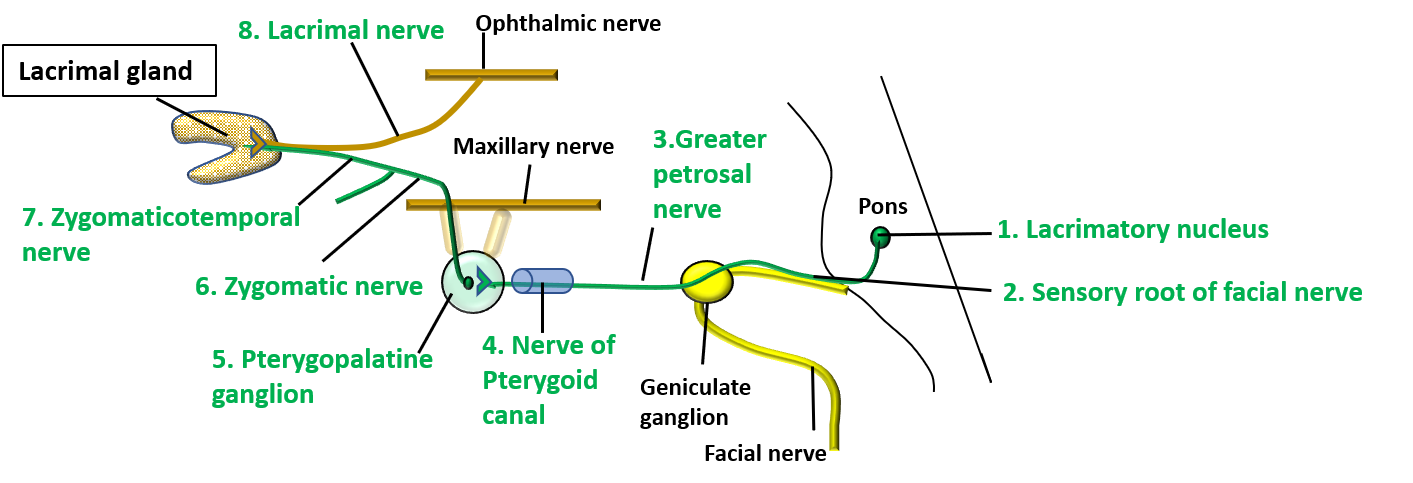Enumerate the Components of Lacrimal apparatus.
The components of lacrimal apparatus include structures involved in tear production and drainage. They are:
- Lacrimal gland.
- Lacrimal ducts.
- Conjunctival sac.
- Lacrimal puncta and lacrimal canaliculi.
- Lacrimal sac.
- Nasolacrimal duct.
Describe Briefly the Components of Lacrimal Apparatus.
Lacrimal gland: It is lodged in the lacrimal fossa, on the anterolateral aspect of roof of bony orbit. It is about the size and shape of an almond, and consists of two parts, the larger orbital and smaller palpebral. The orbital and palpebral parts are continuous with each other around lateral margin of levator palpebrae superioris. It is a serous type of gland and secrete tears.
Lacrimal ducts: The ducts are ten to twelve in number and they all traverse the palpebral part of lacrimal gland to open into the lateral part of the superior conjunctival fornix.
Conjunctival sac: tears in the conjunctival sac (space between the palpebral and bulbar conjunctiva) form a thin-film over the cornea and conjunctiva covering sclera.
Lacrimal Puncta and lacrimal canaliculi: The tears enter the lacrimal canaliculi through the lacrimal puncta which are located on the margin of upper and lower eyelid ( about 6mm lateral to medial angle of eye). The canaliculi are not straight, they first turn downwards (in lower lid) and upwards (in upper lid) and then turn medially to open into lacrimal sac.
Lacrimal sac: It is located in the lacrimal groove on medial wall of orbit. Inferiorly it is continuous with nasolacrimal duct. Lacrimal sac is covered by lacrimal fascia except medially. Lacrimal part of orbicularis oculi is attached to lacrimal facia and its contraction pulls on lacrimal fascia, thereby leading to expansion of lacrimal sac. This helps in drainage of lacrimal fluid into the lacrimal sac.
Nasolacrimal duct: It begins at the lower end of lacrimal sac, passes through an osseous canal to open in the inferior meatus of nose. Its lower end is guarded by mucosal fold called Valve of Hasner which prevents air and nasal secretions from entering the nasolacrimal duct.

Describe the Secretomotor Nerve Supply of Lacrimal Gland.
Preganglionic secretomotor fibers for lacrimal gland arise from the lacrimatory nucleus located in the pons. The fibers successively pass through the sensory root and trunk of facial nerve, greater petrosal nerve, nerve of pterygoid canal and the fibers are relayed in the pterygopalatine ganglion.
Postganglionic fibers pass through the zygomatic nerve (branch of maxillary nerve) , its zygomaticotemporal branch which joins lacrimal nerve( branch of ophthalmic nerve) and reach and supply the lacrimal gland.

Applied Aspect
Surgical removal of only palpebral part of lacrimal gland results in complete absence of tears in the eye.
Lacrimal gland consists of two parts, the larger orbital and smaller palpebral. The orbital and palpebral parts are continuous with each other around lateral margin of levator palpebrae superioris. The secretions from theses parts are drained by ten to twelve ducts ( 4-5 from the orbital part and 6-8 from palpebral part).
As the ducts of the orbital part also pass through the palpebral part, in case the palpebral part is removed surgically, the secretions from the orbital part cannot be drained into the conjunctival sac. Therefore, removal of palpebral part results of complete absence of tears in the eye.

It was really helpful. Thank you !
Helpful,brief and to the point.
Appreciated
Thank you for this, it’s really helping.